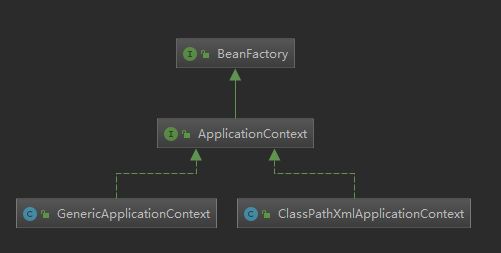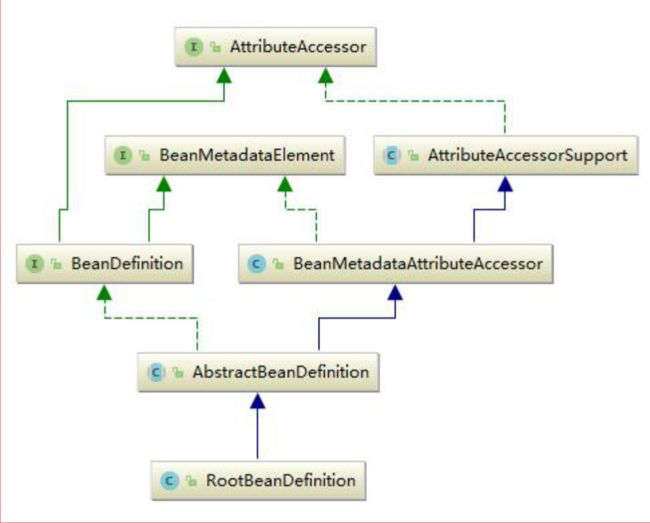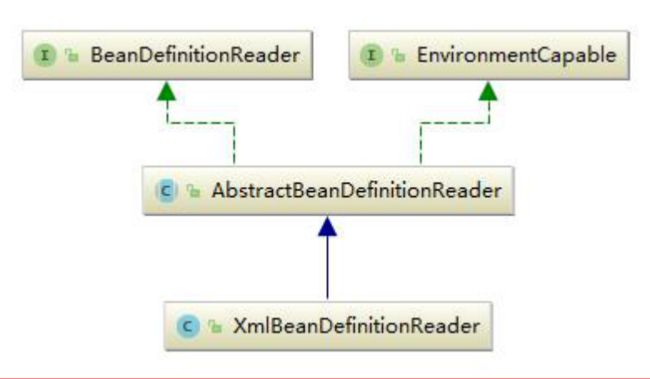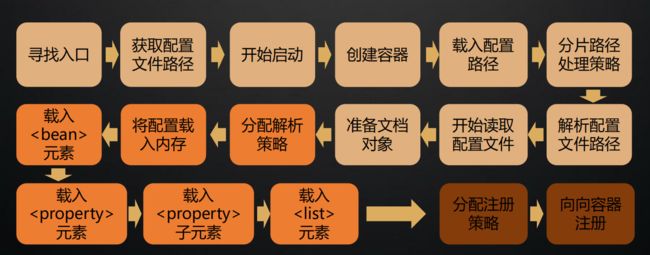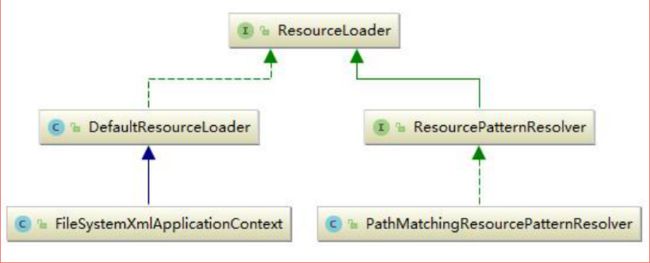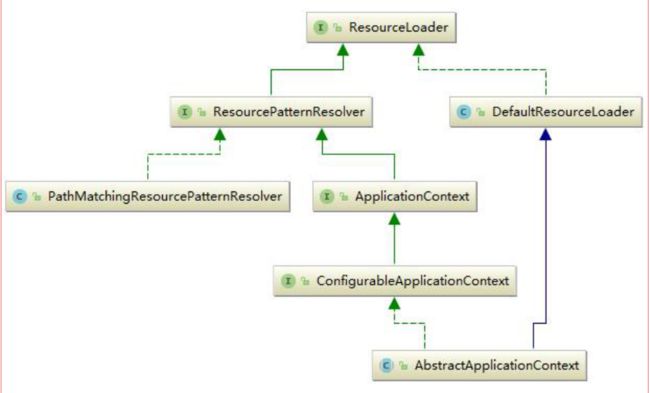BeanFactory
Spring Bean 的创建是典型的工厂模式,这一系列的 Bean 工厂,即 IOC 容器为开发者管理对象
间的依赖关系提供了很多便利和基础服务,在 Spring 中有许多的 IOC 容器的实现供用户选择和使用,
其相互关系如下:
其中 BeanFactory 作为最顶层的一个接口类,它定义了 IOC 容器的基本功能规范,BeanFactory 有三个重要的子类:ListableBeanFactory、HierarchicalBeanFactory 、AutowireCapableBeanFactory
但是从类图中我们可以发现最终的默认实现类是 DefaultListableBeanFactory,它实现了所有的接口
那为何要定义这么多层次的接口呢?
查阅这些接口的源码和说明发现,每个接口都有它使用的场合,它主要是为了区分在 Spring 内部在操作过程中对象的传递和转化过程时,对对象的数据访问所做的限制
例如:
- ListableBeanFactory 接口表示这些 Bean 是可列表化的
- HierarchicalBeanFactory 表示的是这些 Bean 是有继承关系的,也就是每个 Bean 有可能有父 Bean
- AutowireCapableBeanFactory 接口定义 Bean 的自动装配规则
这三个接口共同定义了 Bean 的集合、Bean 之间的关系、以及 Bean 行为
我们来看下最基本的 IOC 容器接口 BeanFactory的源码
import org.springframework.beans.BeansException;
import org.springframework.beans.factory.NoSuchBeanDefinitionException;
import org.springframework.core.ResolvableType;
public interface BeanFactory {
//对 FactoryBean 转义定义,因为如果使用 bean 的名字检索 FactoryBean 得到的对象是工厂生成的对象,如果需要得到工厂本身,需要转义
String FACTORY_BEAN_PREFIX = "&";
//根据 bean 的名字,获取在 IOC 容器中得到 bean 实例
Object getBean(String name) throws BeansException;
//根据 bean 的名字和 Class 类型来得到 bean 实例,增加了类型安全验证机制。
T getBean(String name, @Nullable Class requiredType) throws BeansException;
Object getBean(String name, Object... args) throws BeansException;
T getBean(Class requiredType) throws BeansException;
T getBean(Class requiredType, Object... args) throws BeansException;
//提供对 bean 的检索,看看是否在 IOC 容器有这个名字的 bean
boolean containsBean(String name);
//根据 bean 名字得到 bean 实例,并同时判断这个 bean 是不是单例
boolean isSingleton(String name) throws NoSuchBeanDefinitionException;
boolean isPrototype(String name) throws NoSuchBeanDefinitionException;
boolean isTypeMatch(String name, ResolvableType typeToMatch) throws
NoSuchBeanDefinitionException;
boolean isTypeMatch(String name, @Nullable Class typeToMatch) throws
NoSuchBeanDefinitionException;
//得到 bean 实例的 Class 类型
@Nullable
Class getType(String name) throws NoSuchBeanDefinitionException;
//得到 bean 的别名,如果根据别名检索,那么其原名也会被检索出来
String[] getAliases(String name);
}
从 BeanFactory 里的源码可知,它只是一个接口,只对 IOC 容器的基本行为作了定义,至于Bean 是如何定义怎样加载的并不关心,想知道BeanFactory 如何产生对象,需要看具体的IOC容器的实现类,比如GenericApplicationContext , ClasspathXmlApplicationContext等
ApplicationContext 是 Spring 提供的一个高级的 IOC 容器,它除了能够提供 IOC 容器的基本功能
外,还为用户提供了以下的附加服务。从 ApplicationContext 接口的实现,我们看出其特点:
public interface ApplicationContext extends EnvironmentCapable, ListableBeanFactory, HierarchicalBeanFactory,
MessageSource, ApplicationEventPublisher, ResourcePatternResolver {
1、支持信息源,可以实现国际化(实现 MessageSource 接口)
2、访问资源(实现 ResourcePatternResolver 接口)
3、支持应用事件(实现 ApplicationEventPublisher 接口)
BeanDefinition
SpringIOC 容器管理了我们定义的各种 Bean 对象及其相互的关系,Bean 对象在 Spring 实现中是
以 BeanDefinition 来描述的,其继承体系如下:
BeanDefinitionReader
Bean 的解析过程非常复杂,功能被分的很细,因为这里需要被扩展的地方很多,必须保证有足够的灵活性,以应对可能的变化。Bean 的解析主要就是对 Spring 配置文件的解析。这个解析过程主要通过BeanDefinitionReader 来完成,最后看看 Spring 中 BeanDefinitionReader 的类结构图:
简单描述一下 Spring 解析流程:
1、解析 applicationgContext.xml
2、将 xml 中定义的 bean(如
3、以 beanName(如 userService) 为 key,BeanDefinition(如 UserServiceImpl) 为 value 存储到 DefaultListableBeanFactory 中的 beanDefinitionMap (其实就是一个 ConcurrentHashMap) 中
public class DefaultListableBeanFactory extends AbstractAutowireCapableBeanFactory
implements ConfigurableListableBeanFactory, BeanDefinitionRegistry, Serializable {
/** Map of bean definition objects, keyed by bean name */
//存储注册信息的BeanDefinition
private final Map beanDefinitionMap = new ConcurrentHashMap<>(256);
/** List of bean definition names, in registration order */
private volatile List beanDefinitionNames = new ArrayList<>(256);
4、同时将 beanName 存入 beanDefinitionNames(List 类型) 中,然后遍历 beanDefinitionNames 中的 beanName,进行 bean 的实例化并填充属性,在实例化的过程中,如果有依赖没有被实例化将先实例化其依赖,然后实例化本身,实例化完成后将实例存入单例 bean 的缓存中,当调用 getBean 方法时,到单例 bean 的缓存中查找,如果找到并经过转换后返回这个实例 (如 userService的实例),之后就可以直接使用了
大致了解下,后续会详细跟进代码详情
Web IOC 容器
从最熟悉的 DispatcherServlet 开始,最先想到的还是 DispatcherServlet 的 init()方法。发现在 DispatherServlet 中并没有找到 init()方法。但是往上追索在其父类的父类HttpServletBean 中找到了init()方法
@Override
public final void init() throws ServletException {
if (logger.isDebugEnabled()) {
logger.debug("Initializing servlet '" + getServletName() + "'");
}
// Set bean properties from init parameters.
PropertyValues pvs = new ServletConfigPropertyValues(getServletConfig(), this.requiredProperties);
if (!pvs.isEmpty()) {
try {
//定位资源
BeanWrapper bw = PropertyAccessorFactory.forBeanPropertyAccess(this);
//加载配置信息
ResourceLoader resourceLoader = new ServletContextResourceLoader(getServletContext());
bw.registerCustomEditor(Resource.class, new ResourceEditor(resourceLoader, getEnvironment()));
initBeanWrapper(bw);
bw.setPropertyValues(pvs, true);
}
catch (BeansException ex) {
if (logger.isErrorEnabled()) {
logger.error("Failed to set bean properties on servlet '" + getServletName() + "'", ex);
}
throw ex;
}
}
// Let subclasses do whatever initialization they like.
//真正完成初始化容器动作的逻辑在initServletBean方法中
initServletBean();
if (logger.isDebugEnabled()) {
logger.debug("Servlet '" + getServletName() + "' configured successfully");
}
}
在 init()方法中,真正完成初始化容器动作的逻辑其实在 initServletBean()方法中,我们继续跟进
initServletBean()中的代码在其子类 FrameworkServlet 类中
@Override
protected final void initServletBean() throws ServletException {
getServletContext().log("Initializing Spring FrameworkServlet '" + getServletName() + "'");
if (this.logger.isInfoEnabled()) {
this.logger.info("FrameworkServlet '" + getServletName() + "': initialization started");
}
long startTime = System.currentTimeMillis();
try {
//看这个方法initWebApplicationContext
this.webApplicationContext = initWebApplicationContext();
initFrameworkServlet();
}
catch (ServletException ex) {
this.logger.error("Context initialization failed", ex);
throw ex;
}
catch (RuntimeException ex) {
this.logger.error("Context initialization failed", ex);
throw ex;
}
if (this.logger.isInfoEnabled()) {
long elapsedTime = System.currentTimeMillis() - startTime;
this.logger.info("FrameworkServlet '" + getServletName() + "': initialization completed in " +
elapsedTime + " ms");
}
}
继续跟进 initWebAppplicationContext()方法
protected WebApplicationContext initWebApplicationContext() {
//先从 ServletContext 中获得父容器 WebAppliationContext
WebApplicationContext rootContext =
WebApplicationContextUtils.getWebApplicationContext(getServletContext());
//声明子容器
WebApplicationContext wac = null;
//建立父、子容器之间的关联关系
if (this.webApplicationContext != null) {
// A context instance was injected at construction time -> use it
wac = this.webApplicationContext;
if (wac instanceof ConfigurableWebApplicationContext) {
ConfigurableWebApplicationContext cwac = (ConfigurableWebApplicationContext) wac;
if (!cwac.isActive()) {
// The context has not yet been refreshed -> provide services such as
// setting the parent context, setting the application context id, etc
if (cwac.getParent() == null) {
// The context instance was injected without an explicit parent -> set
// the root application context (if any; may be null) as the parent
cwac.setParent(rootContext);
}
configureAndRefreshWebApplicationContext(cwac);
}
}
}
//先去 ServletContext 中查找 Web 容器的引用是否存在,并创建好默认的空 IOC 容器
if (wac == null) {
// No context instance was injected at construction time -> see if one
// has been registered in the servlet context. If one exists, it is assumed
// that the parent context (if any) has already been set and that the
// user has performed any initialization such as setting the context id
wac = findWebApplicationContext();
}
//给上一步创建好的 IOC 容器赋值
if (wac == null) {
// No context instance is defined for this servlet -> create a local one
wac = createWebApplicationContext(rootContext);
}
//触发 onRefresh 方法
if (!this.refreshEventReceived) {
// Either the context is not a ConfigurableApplicationContext with refresh
// support or the context injected at construction time had already been
// refreshed -> trigger initial onRefresh manually here.
onRefresh(wac);//最终还是调用子类DispatcherServlet的onRefresh方法
}
if (this.publishContext) {
// Publish the context as a servlet context attribute.
String attrName = getServletContextAttributeName();
getServletContext().setAttribute(attrName, wac);
if (this.logger.isDebugEnabled()) {
this.logger.debug("Published WebApplicationContext of servlet '" + getServletName() +
"' as ServletContext attribute with name [" + attrName + "]");
}
}
return wac;
}
最后调用了DispatcherServlet 的 onRefresh()方法,在 onRefresh()方法中又是直接调用 initStrategies()方法初始化 SpringMVC 的九大组件
@Override
protected void onRefresh(ApplicationContext context) {
initStrategies(context);//初始化策略
}
/**
* Initialize the strategy objects that this servlet uses.
* May be overridden in subclasses in order to initialize further strategy objects.
*/
//初始化 SpringMVC 的九大组件
protected void initStrategies(ApplicationContext context) {
//多文件上传的组件
initMultipartResolver(context);
//初始化本地语言环境
initLocaleResolver(context);
//初始化模板处理器
initThemeResolver(context);
//handlerMapping
initHandlerMappings(context);
//初始化参数适配器
initHandlerAdapters(context);
//初始化异常拦截器
initHandlerExceptionResolvers(context);
//初始化视图预处理器
initRequestToViewNameTranslator(context);
//初始化视图转换器
initViewResolvers(context);
//FlashMapManager
initFlashMapManager(context);
}
基于 Xml 的 IOC 容器的初始化
IOC 容器的初始化包括 BeanDefinition 的 Resource 定位、加载、注册这三个基本的过程。我们以
ApplicationContext 为例讲解,ApplicationContext 系列容器也许是我们最熟悉的,因为 Web 项目
中使用的 XmlWebApplicationContext 就属于这个继承体系,还有 ClasspathXmlApplicationContext等,其继承体系如下图所示
ApplicationContext 允许上下文嵌套,通过保持父上下文可以维持一个上下文体系。对于 Bean 的查找可以在这个上下文体系中发生,首先检查当前上下文,其次是父上下文,逐级向上,这样为不同的 Spring应用提供了一个共享的 Bean 定义环境
定位、加载和注册的三大步骤按照下图,总共有17个步骤,我们一步一步的看源码
1.寻找入口
main方法启动
ApplicationContext app = new ClassPathXmlApplicationContext("application.xml");
看其构造方法
public ClassPathXmlApplicationContext(String configLocation) throws BeansException {
this(new String[]{configLocation}, true, (ApplicationContext)null);
}
ublic ClassPathXmlApplicationContext(
String[] configLocations, boolean refresh, @Nullable ApplicationContext parent)
throws BeansException {
//调用父类的构造方法super(parent)方法为容器设置好 Bean 资源加载器
super(parent);
//调用父类的setConfigLocations方法设置 Bean 配置信息的定位路径
setConfigLocations(configLocations);
if (refresh) {
//AnnotationConfigApplicationContext 、 FileSystemXmlApplicationContext 、XmlWebApplicationContext 等都继承自父容器 AbstractApplicationContext主要用到了装饰器模和策略模式,最终都是调用 refresh()方法
refresh();
}
}
AnnotationConfigApplicationContext 、 FileSystemXmlApplicationContext 、XmlWebApplicationContext 等都继承自父容器 AbstractApplicationContext主要用到了装饰器模和策略模式,最终都是调用 refresh()方法
2.获得配置路径
1、先看看ClassPathXmlApplicationContext父类的父类的父类的父类
AbstractApplicationContext 类中初始化 IOC 容器所做的主要源码如下
public abstract class AbstractApplicationContext extends DefaultResourceLoader
implements ConfigurableApplicationContext {
//静态初始化块,在整个容器创建过程中只执行一次
static {
//为了避免应用程序在 Weblogic8.1 关闭时出现类加载异常加载问题,加载 IOC 容
//器关闭事件(ContextClosedEvent)类
ContextClosedEvent.class.getName();
}
public AbstractApplicationContext() {
this.resourcePatternResolver = getResourcePatternResolver();
}
public AbstractApplicationContext(@Nullable ApplicationContext parent) {
this();
setParent(parent);
}
//获取一个 Spring Source 的加载器用于读入 Spring Bean 配置信息
protected ResourcePatternResolver getResourcePatternResolver() {
//AbstractApplicationContext 继承 DefaultResourceLoader,因此也是一个资源加载器
//Spring 资源加载器,其 getResource(String location)方法用于载入资源
return new PathMatchingResourcePatternResolver(this);
}
...
}
AbstractApplicationContext 的默认构造方法中有调用 PathMatchingResourcePatternResolver 的
构造方法创建 Spring 资源加载器
public PathMatchingResourcePatternResolver(ResourceLoader resourceLoader) {
Assert.notNull(resourceLoader, "ResourceLoader must not be null");
//设置 Spring 的资源加载器
this.resourceLoader = resourceLoader;
}
在设置容器的资源加载器之后,接下来 ClassPathXmlApplicationContext 执行 setConfigLocations()方法通过调用其父类AbstractRefreshableConfigApplicationContext的方法进行对Bean配置信息的定位,该方法的源码如下:
public abstract class AbstractRefreshableConfigApplicationContext extends AbstractRefreshableApplicationContext
implements BeanNameAware, InitializingBean {
@Nullable
private String[] configLocations;
String CONFIG_LOCATION_DELIMITERS = ",; \t\n";
//处理单个资源文件路径为一个字符串的情况
public void setConfigLocation(String location) {
//String CONFIG_LOCATION_DELIMITERS = ",; /t/n";
//即多个资源文件路径之间用” ,; \t\n”分隔,解析成数组形式
setConfigLocations(StringUtils.tokenizeToStringArray(location, CONFIG_LOCATION_DELIMITERS));
}
//解析Bean定义资源文件的路径,处理多个资源文件字符串数组
public void setConfigLocations(@Nullable String... locations) {
if (locations != null) {
Assert.noNullElements(locations, "Config locations must not be null");
this.configLocations = new String[locations.length];
for (int i = 0; i < locations.length; i++) {
// resolvePath为同一个类中将字符串解析为路径的方法
this.configLocations[i] = resolvePath(locations[i]).trim();
}
}
else {
this.configLocations = null;
}
}
}
通过这两个方法的源码我们可以看出,我们既可以使用一个字符串来配置多个 Spring Bean 配置信息,
也可以使用字符串数组,即下面两种方式都是可以的:
ClassPathResource res = new ClassPathResource("a.xml,b.xml");
多个资源文件路径之间可以是用” , ; \t\n”等分隔。
ClassPathResource res =new ClassPathResource(new String[]{"a.xml","b.xml"});
至此,SpringIOC 容器在初始化时将配置的 Bean 配置信息定位为 Spring 封装的 Resource
3.容器启动
SpringIOC 容器对 Bean 配置资源的载入是从 refresh()函数开始的,refresh()是一个模板方法,规定了IOC 容 器 的 启 动 流 程 , 有 些 逻 辑 要 交 给 其 子 类 去 实 现 。 它 对 Bean 配 置 资 源 进 行 载 入ClassPathXmlApplicationContext 通过调用其父类 AbstractApplicationContext 的 refresh()函数启动整个 IOC 容器对 Bean 定义的载入过程,现在我们来详细看看 refresh()中的逻辑处理
@Override
public void refresh() throws BeansException, IllegalStateException {
synchronized (this.startupShutdownMonitor) {
// Prepare this context for refreshing.
//1.调用容器准备刷新的方法,获取容器的当时时间,同时给容器设置同步标识
prepareRefresh();
// Tell the subclass to refresh the internal bean factory.
//2.告诉子类启动refreshBeanFactory()方法,Bean定义资源文件的载入从
//子类的refreshBeanFactory()方法启动
ConfigurableListableBeanFactory beanFactory = obtainFreshBeanFactory();
// Prepare the bean factory for use in this context.
//3.为BeanFactory配置容器特性,例如类加载器、事件处理器等
prepareBeanFactory(beanFactory);
try {
// Allows post-processing of the bean factory in context subclasses.
//4.为容器的某些子类指定特殊的BeanPost事件处理器
postProcessBeanFactory(beanFactory);
// Invoke factory processors registered as beans in the context.
//5.调用所有注册的BeanFactoryPostProcessor的Bean
invokeBeanFactoryPostProcessors(beanFactory);
// Register bean processors that intercept bean creation.
//6.为BeanFactory注册BeanPost事件处理器.
//BeanPostProcessor是Bean后置处理器,用于监听容器触发的事件
registerBeanPostProcessors(beanFactory);
// Initialize message source for this context.
//7.初始化信息源,和国际化相关.
initMessageSource();
// Initialize event multicaster for this context.
//8.初始化容器事件传播器.
initApplicationEventMulticaster();
// Initialize other special beans in specific context subclasses.
//9.调用子类的某些特殊Bean初始化方法
onRefresh();
// Check for listener beans and register them.
//10.为事件传播器注册事件监听器.
registerListeners();
// Instantiate all remaining (non-lazy-init) singletons.
//11.初始化所有剩余的单例Bean
finishBeanFactoryInitialization(beanFactory);
// Last step: publish corresponding event.
//12.初始化容器的生命周期事件处理器,并发布容器的生命周期事件
finishRefresh();
}catch (BeansException ex) {
if (logger.isWarnEnabled()) {
logger.warn("Exception encountered during context initialization - " +
"cancelling refresh attempt: " + ex);
}
// Destroy already created singletons to avoid dangling resources.
//13.销毁已创建的Bean
destroyBeans();
// Reset 'active' flag.
//14.取消refresh操作,重置容器的同步标识.
cancelRefresh(ex);
// Propagate exception to caller.
throw ex;
}finally {
// Reset common introspection caches in Spring's core, since we
// might not ever need metadata for singleton beans anymore...
//15.重设公共缓存
resetCommonCaches();
}
}
}
refresh()方法主要为 IOC 容器 Bean 的生命周期管理提供条件,Spring IOC 容器载入 Bean 配置信息从 其 子 类 容 器 的 refreshBeanFactory() 方 法 启 动 , 所 以 整 个 refresh() 中
“ConfigurableListableBeanFactory beanFactory = obtainFreshBeanFactory();”这句以后的代码
都是注册容器的信息源和生命周期事件,前面说的载入就是从这句代码开始启动
refresh()方法的主要作用是:在创建 IOC 容器前,如果已经有容器存在,则需要把已有的容器销毁和关闭,以保证在 refresh 之后使用的是新建立起来的 IOC 容器。它类似于对 IOC 容器的重启,在新建立好的容器中对容器进行初始化,对 Bean 配置资源进行载入
4.创建容器
obtainFreshBeanFactory()方法调用子类容器的 refreshBeanFactory()方法,启动容器载入 Bean 配置信息的过程,代码如下:
protected ConfigurableListableBeanFactory obtainFreshBeanFactory() {
//这里使用了委派设计模式,父类定义了抽象的refreshBeanFactory()方法,具体实现调用子类AbstractRefreshableApplicationContext容器的refreshBeanFactory()方法
refreshBeanFactory();
ConfigurableListableBeanFactory beanFactory = getBeanFactory();
if (logger.isDebugEnabled()) {
logger.debug("Bean factory for " + getDisplayName() + ": " + beanFactory);
}
return beanFactory;
}
//子类AbstractRefreshableApplicationContext的refreshBeanFactory方法
@Override
protected final void refreshBeanFactory() throws BeansException {
//如果已经有容器,销毁容器中的bean,关闭容器
if (hasBeanFactory()) {
destroyBeans();
closeBeanFactory();
}
try {
//创建IOC容器
DefaultListableBeanFactory beanFactory = createBeanFactory();
beanFactory.setSerializationId(getId());
//对IOC容器进行定制化,如设置启动参数,开启注解的自动装配等
customizeBeanFactory(beanFactory);
//调用载入Bean定义的方法,主要这里又使用了一个委派模式,在当前类中只定义了抽象的loadBeanDefinitions方法,具体的实现调用子类容器
loadBeanDefinitions(beanFactory);
synchronized (this.beanFactoryMonitor) {
this.beanFactory = beanFactory;
}
}
catch (IOException ex) {
throw new ApplicationContextException("I/O error parsing bean definition source for " + getDisplayName(), ex);
}
}
在这个refreshBeanFactory方法中,先判断 BeanFactory 是否存在,如果存在则先销毁 beans 并关闭 beanFactory,接着创建 DefaultListableBeanFactory,并调用loadBeanDefinitions(beanFactory)装载 bean 定义
5.载入配置路径
AbstractRefreshableApplicationContext 中只定义了抽象的 loadBeanDefinitions 方法,容器真正调
用的是其子类 AbstractXmlApplicationContext 对该方法的实现,AbstractXmlApplicationContext
的主要源码如下:
public abstract class AbstractXmlApplicationContext extends AbstractRefreshableConfigApplicationContext {
//实现父类抽象的载入Bean定义方法
@Override
protected void loadBeanDefinitions(DefaultListableBeanFactory beanFactory) throws BeansException, IOException {
// Create a new XmlBeanDefinitionReader for the given BeanFactory.
//创建XmlBeanDefinitionReader,即创建Bean读取器,并通过回调设置到容器中去,容 器使用该读取器读取Bean定义资源
XmlBeanDefinitionReader beanDefinitionReader = new XmlBeanDefinitionReader(beanFactory);
// Configure the bean definition reader with this context's
// resource loading environment.
//为Bean读取器设置Spring资源加载器,AbstractXmlApplicationContext的
//祖先父类AbstractApplicationContext继承DefaultResourceLoader,因此,容器本身也是一个资源加载器
beanDefinitionReader.setEnvironment(this.getEnvironment());
beanDefinitionReader.setResourceLoader(this);
//为Bean读取器设置SAX xml解析器
beanDefinitionReader.setEntityResolver(new ResourceEntityResolver(this));
// Allow a subclass to provide custom initialization of the reader,
// then proceed with actually loading the bean definitions.
//当Bean读取器读取Bean定义的Xml资源文件时,启用Xml的校验机制
initBeanDefinitionReader(beanDefinitionReader);
//Bean读取器真正实现加载的方法
loadBeanDefinitions(beanDefinitionReader);
}
protected void initBeanDefinitionReader(XmlBeanDefinitionReader reader) {
reader.setValidating(this.validating);
}
//Xml Bean读取器加载Bean定义资源
protected void loadBeanDefinitions(XmlBeanDefinitionReader reader) throws BeansException, IOException {
//获取Bean定义资源的定位
Resource[] configResources = getConfigResources();
if (configResources != null) {
//Xml Bean读取器调用其父类AbstractBeanDefinitionReader读取定位
//的Bean定义资源
reader.loadBeanDefinitions(configResources);
}
//如果子类中获取的Bean定义资源定位为空,则获取FileSystemXmlApplicationContext构造方法中setConfigLocations方法设置的资源
String[] configLocations = getConfigLocations();
if (configLocations != null) {
//Xml Bean读取器调用其父类AbstractBeanDefinitionReader读取定位
//的Bean定义资源
reader.loadBeanDefinitions(configLocations);
}
}
//这里又使用了一个委托模式,调用子类的获取Bean定义资源定位的方法
//该方法在ClassPathXmlApplicationContext中进行实现,对于我们
//举例分析源码的FileSystemXmlApplicationContext没有使用该方法
@Nullable
protected Resource[] getConfigResources() {
return null;
}
}
以 XmlBean 读取器的其中一种策略 XmlBeanDefinitionReader 为例。XmlBeanDefinitionReader 调用其父类AbstractBeanDefinitionReader的 reader.loadBeanDefinitions()方法读取Bean配置资源。由于我们使用 ClassPathXmlApplicationContext 作为例子分析,因此 getConfigResources 的返回值为 null,因此程序执行 reader.loadBeanDefinitions(configLocations)分支
6.分配路径处理策略
在 AbstractBeanDefinitionReader 的抽象父类 AbstractBeanDefinitionReader 中定义了载入过程。
AbstractBeanDefinitionReader 的 loadBeanDefinitions()方法源码如下:
public int loadBeanDefinitions(String location, @Nullable Set actualResources) throws BeanDefinitionStoreException {
//获取在IoC容器初始化过程中设置的资源加载器
ResourceLoader resourceLoader = getResourceLoader();
if (resourceLoader == null) {
throw new BeanDefinitionStoreException(
"Cannot import bean definitions from location [" + location + "]: no ResourceLoader available");
}
if (resourceLoader instanceof ResourcePatternResolver) {
// Resource pattern matching available.
try {
//1.将指定位置的Bean定义资源文件解析为Spring IOC容器封装的资源
//加载多个指定位置的Bean定义资源文件
Resource[] resources = ((ResourcePatternResolver) resourceLoader).getResources(location);
//委派调用其子类XmlBeanDefinitionReader的方法,实现加载功能
int loadCount = loadBeanDefinitions(resources);
if (actualResources != null) {
for (Resource resource : resources) {
actualResources.add(resource);
}
}
if (logger.isDebugEnabled()) {
logger.debug("Loaded " + loadCount + " bean definitions from location pattern [" + location + "]");
}
return loadCount;
}
catch (IOException ex) {
throw new BeanDefinitionStoreException(
"Could not resolve bean definition resource pattern [" + location + "]", ex);
}
}
else {
// Can only load single resources by absolute URL.
//2.将指定位置的Bean定义资源文件解析为Spring IOC容器封装的资源
//加载单个指定位置的Bean定义资源文件
Resource resource = resourceLoader.getResource(location);
//委派调用其子类XmlBeanDefinitionReader的方法,实现加载功能
int loadCount = loadBeanDefinitions(resource);
if (actualResources != null) {
actualResources.add(resource);
}
if (logger.isDebugEnabled()) {
logger.debug("Loaded " + loadCount + " bean definitions from location [" + location + "]");
}
return loadCount;
}
}
//重载方法,调用loadBeanDefinitions(String);
@Override
public int loadBeanDefinitions(String... locations) throws BeanDefinitionStoreException {
Assert.notNull(locations, "Location array must not be null");
int counter = 0;
for (String location : locations) {
counter += loadBeanDefinitions(location);
}
return counter;
}
从上面代码可知该方法就做了两件事:
- 首先,调用资源加载器的获取资源方法 resourceLoader.getResource(location),获取到要加载的资源。
-
其次,真正执行加载功能是其子类 XmlBeanDefinitionReader 的 loadBeanDefinitions()方法。在
loadBeanDefinitions()方法中调用了 AbstractApplicationContext 的 getResources()方法,跟进去之后发现 getResources()方法其实定义在 ResourcePatternResolver 中,此时,我们有必要来看一下ResourcePatternResolver 的全类图
从上面可以看到 ResourceLoader 与 ApplicationContext 的继承关系,可以看出其实际调用的是
DefaultResourceLoader 中 的 getSource() 方 法 定 位 Resource , 因 为
ClassPathXmlApplicationContext 本身就是 DefaultResourceLoader 的实现类,所以此时又回到了
ClassPathXmlApplicationContext 中来
7.解析配置文件路径
XmlBeanDefinitionReader 通 过 调 用 ClassPathXmlApplicationContext 的 父 类
DefaultResourceLoader 的 getResource()方法获取要加载的资源,其源码如下
//获取Resource的具体实现方法
@Override
public Resource getResource(String location) {
Assert.notNull(location, "Location must not be null");
for (ProtocolResolver protocolResolver : this.protocolResolvers) {
Resource resource = protocolResolver.resolve(location, this);
if (resource != null) {
return resource;
}
}
//如果是类路径的方式,那需要使用ClassPathResource 来得到bean 文件的资源对象
if (location.startsWith("/")) {
return getResourceByPath(location);
}
else if (location.startsWith(CLASSPATH_URL_PREFIX)) {
return new ClassPathResource(location.substring(CLASSPATH_URL_PREFIX.length()), getClassLoader());
}
else {
try {
// Try to parse the location as a URL...
// 如果是URL 方式,使用UrlResource 作为bean 文件的资源对象
URL url = new URL(location);
return (ResourceUtils.isFileURL(url) ? new FileUrlResource(url) : new UrlResource(url));
}
catch (MalformedURLException ex) {
// No URL -> resolve as resource path.
//如果既不是classpath标识,又不是URL标识的Resource定位,则调用
//容器本身的getResourceByPath方法获取Resource
return getResourceByPath(location);
}
}
}
DefaultResourceLoader 提供了 getResourceByPath()方法的实现,就是为了处理既不是 classpath标识,又不是 URL 标识的 Resource 定位这种情况
protected Resource getResourceByPath(String path) {
return new ClassPathContextResource(path, getClassLoader());
}
在 ClassPathResource 中完成了对整个路径的解析。这样,就可以从类路径上对 IOC 配置文件进行加载,当然我们可以按照这个逻辑从任何地方加载,在 Spring 中我们看到它提供的各种资源抽象,比如ClassPathResource、URLResource、FileSystemResource 等来供我们使用。上面我们看到的是定位Resource 的一个过程,而这只是加载过程的一部分。例如 FileSystemXmlApplication 容器就重写了getResourceByPath()方法
@Override
protected Resource getResourceByPath(String path) {
if (path.startsWith("/")) {
path = path.substring(1);
}
//这里使用文件系统资源对象来定义 bean 文件
return new FileSystemResource(path);
}
通过子类的覆盖,巧妙地完成了将类路径变为文件路径的转换
8.开始读取配置内容
继续回到 XmlBeanDefinitionReader 的 loadBeanDefinitions(Resource …)方法看到代表 bean 文件的资源定义以后的载入过程。
//这里是载入XML形式Bean定义资源文件方法
public int loadBeanDefinitions(EncodedResource encodedResource) throws BeanDefinitionStoreException {
...
//这里是具体的读取过程
return doLoadBeanDefinitions(inputSource, encodedResource.getResource());
...
}
//从特定XML文件中实际载入Bean定义资源的方法
protected int doLoadBeanDefinitions(InputSource inputSource, Resource resource)
throws BeanDefinitionStoreException {
try {
//将XML文件转换为DOM对象,解析过程由doLoadDocument()实现
Document doc = doLoadDocument(inputSource, resource);
//这里是启动对Bean定义解析的详细过程,该解析过程会用到Spring的Bean配置规则
return registerBeanDefinitions(doc, resource);
}
...
}
通过源码分析,载入 Bean 配置信息的最后一步是将 Bean 配置信息转换为 Document 对象,该过程由doLoadDocument()方法实现
9.准备文档对象
跟进 doLoadDocument方法
protected Document doLoadDocument(InputSource inputSource, Resource resource) throws Exception {
return this.documentLoader.loadDocument(inputSource, getEntityResolver(), this.errorHandler,
getValidationModeForResource(resource), isNamespaceAware());
}
进入DefaultDocumentLoader类的loadDocument方法
public class DefaultDocumentLoader implements DocumentLoader {
//使用标准的JAXP将载入的Bean定义资源转换成document对象
@Override
public Document loadDocument(InputSource inputSource, EntityResolver entityResolver,
ErrorHandler errorHandler, int validationMode, boolean namespaceAware) throws Exception {
//创建文件解析器工厂
DocumentBuilderFactory factory = createDocumentBuilderFactory(validationMode, namespaceAware);
if (logger.isDebugEnabled()) {
logger.debug("Using JAXP provider [" + factory.getClass().getName() + "]");
}
//创建文档解析器
DocumentBuilder builder = createDocumentBuilder(factory, entityResolver, errorHandler);
//解析Spring的Bean定义资源
return builder.parse(inputSource);
}
protected DocumentBuilderFactory createDocumentBuilderFactory(int validationMode, boolean namespaceAware)
throws ParserConfigurationException {
//创建文档解析工厂
DocumentBuilderFactory factory = DocumentBuilderFactory.newInstance();
factory.setNamespaceAware(namespaceAware);
//设置解析XML的校验
if (validationMode != XmlValidationModeDetector.VALIDATION_NONE) {
factory.setValidating(true);
if (validationMode == XmlValidationModeDetector.VALIDATION_XSD) {
// Enforce namespace aware for XSD...
factory.setNamespaceAware(true);
try {
factory.setAttribute(SCHEMA_LANGUAGE_ATTRIBUTE, XSD_SCHEMA_LANGUAGE);
}
catch (IllegalArgumentException ex) {
ParserConfigurationException pcex = new ParserConfigurationException(
"Unable to validate using XSD: Your JAXP provider [" + factory +
"] does not support XML Schema. Are you running on Java 1.4 with Apache Crimson? " +
"Upgrade to Apache Xerces (or Java 1.5) for full XSD support.");
pcex.initCause(ex);
throw pcex;
}
}
}
return factory;
}
}
上面的解析过程是调用 JavaEE 标准的 JAXP 标准进行处理。至此 Spring IOC 容器根据定位的 Bean 配置信息,将其加载读入并转换成为 Document 对象过程完成。接下来我们要继续分析 Spring IOC 容器将载入的 Bean 配置信息转换为 Document 对象之后,是如何将其解析为 Spring IOC 管理的 Bean 对象并将其注册到容器中的
下一章会讲解解析和注册都剩余流程:
10.分配解析策略
11.将配置载入内存
12.载入
13.载入
14.载入
15.载入的子元素
16.分配注册策略
17.向容器注册
——学自咕泡学院

